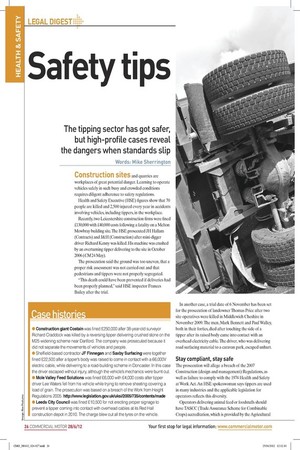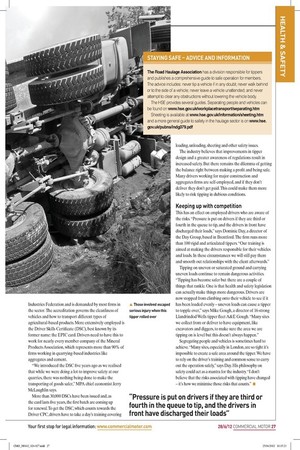Safety tips
Page 18

Page 19

If you've noticed an error in this article please click here to report it so we can fix it.
The tipping sector has got safer, but high-profile cases reveal the dangers when standards slip
Words: Mike Sherrington Construction sites and quarries are workplaces of great potential danger. Learning to operate vehicles safely in such busy and crowded conditions requires diligent adherence to safety regulations.
Health and Safety Executive (HSE) figures show that 70 people are killed and 2,500 injured every year in accidents involving vehicles, including tippers, in the workplace.
Recently, two Leicestershire construction firms were fined £130,000 with £40,000 costs following a fatality on a Melton Mowbray building site. The HSE prosecuted JH Hallam (Contracts) and J&H (Construction) after mini-digger driver Richard Kenny was killed. His machine was crushed by an overturning tipper delivering to the site in October 2006 (CM 24 May).
The prosecution said the ground was too uneven, that a proper risk assessment was not carried out and that pedestrians and tippers were not properly segregated.
“This death could have been prevented if deliveries had been properly planned,” said HSE inspector Frances Bailey after the trial. In another case, a trial date of 6 November has been set for the prosecution of landowner Thomas Price after two site operatives were killed in Middlewich Cheshire in November 2009. The men, Mark Bennett and Paul Walley, both in their forties, died after touching the side of a tipper after its raised body came into contact with an overhead electricity cable. The driver, who was delivering road surfacing material to a caravan park, escaped unhurt.
Stay compliant, stay safe
The prosecution will allege a breach of the 2007 Construction (design and management) Regulations, as well as failure to comply with the 1974 Health and Safety at Work Act. An HSE spokeswoman says tippers are used in many industries and the applicable legislation for operators reflects this diversity.
Operators delivering animal feed or foodstuffs should have TASCC (Trade Assurance Scheme for Combinable Crops) accreditation, which is provided by the Agricultural Industries Federation and is demanded by most firms in the sector. The accreditation governs the cleanliness of vehicles and how to transport different types of agricultural-based products. More extensively employed is the Driver Skills Certificate (DSC), best known by its former name: the EPIC card. Drivers need to have this to work for nearly every member company of the Mineral Products Association, which represents more than 90% of firms working in quarrying-based industries like aggregates and cement.
“We introduced the DSC five years ago as we realised that while we were doing a lot to improve safety at our quarries, there was nothing being done to make the transporting of goods safer,” MPA chief economist Jerry McLaughlin says.
More than 30,000 DSCs have been issued and, as the card lasts five years, the first batch are coming up for renewal. To get the DSC, which counts towards the Driver CPC, drivers have to take a day’s training covering loading, unloading, sheeting and other safety issues.
The industry believes that improvements in tipper design and a greater awareness of regulations result in increased safety. But there remains the dilemma of getting the balance right between making a profit and being safe. Many drivers working for major construction and aggregates firms are self-employed, and if they don’t deliver they don’t get paid. This could make them more likely to risk tipping in dubious conditions.
Keeping up with competition
This has an effect on employed drivers who are aware of the risks. “Pressure is put on drivers if they are third or fourth in the queue to tip, and the drivers in front have discharged their loads,” says Dominic Day, a director of the Day Group, based in Brentford. The firm runs more than 100 rigid and articulated tippers. “Our training is aimed at making the drivers responsible for their vehicles and loads. In these circumstances we will still pay them and smooth out relationships with the client afterwards.” Tipping on uneven or saturated ground and carrying uneven loads continue to remain dangerous activities. “Tipping has become safer but there are a couple of things that rankle. One is that health and safety legislation can actually make things more dangerous. Drivers are now stopped from climbing onto their vehicle to see if it has been loaded evenly – uneven loads can cause a tipper to topple over,” says Mike Gough, a director of 16-strong Llandrindod Wells tipper fleet A&E Gough. “Many sites we collect from or deliver to have equipment, like excavators and diggers, to make sure the area we are tipping on is level but this doesn’t always happen.” Segregating people and vehicles is sometimes hard to achieve. “Many sites, especially in London, are so tight it’s impossible to create a safe area around the tipper. We have to rely on the driver’s training and common sense to carry out the operation safely,” says Day. His philosophy on safety could act as a mantra for the industry. “I don’t believe that the risks associated with tipping have changed – it’s how we minimise those risks that counts.” n










































